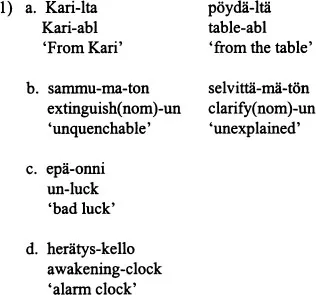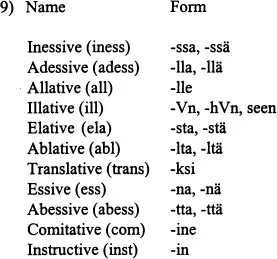
eBook - ePub
Grammatical Case Assignment in Finnish
Diane C. Nelson
This is a test
Share book
- 282 pages
- English
- ePUB (mobile friendly)
- Available on iOS & Android
eBook - ePub
Grammatical Case Assignment in Finnish
Diane C. Nelson
Book details
Book preview
Table of contents
Citations
About This Book
First Published in 1998. This book is a revision of the author's 1995 University of Edinburgh dissertation entitled X° Categories and Grammatical Case Assignment in Finnish. This work provides a structural account for patterns of grammatical case in Finnish within the Principles and Parameters framework. The rich case and agreement morphology of Finnish make it an important language for testing hypotheses about the relationships between morphological case and abstract Case, and Case/case and agreement. In particular, several case 'splits' occur in Finnish which challenge standard theoretical accounts about the relationship between abstract and morphological case.
Frequently asked questions
How do I cancel my subscription?
Can/how do I download books?
At the moment all of our mobile-responsive ePub books are available to download via the app. Most of our PDFs are also available to download and we're working on making the final remaining ones downloadable now. Learn more here.
What is the difference between the pricing plans?
Both plans give you full access to the library and all of Perlego’s features. The only differences are the price and subscription period: With the annual plan you’ll save around 30% compared to 12 months on the monthly plan.
What is Perlego?
We are an online textbook subscription service, where you can get access to an entire online library for less than the price of a single book per month. With over 1 million books across 1000+ topics, we’ve got you covered! Learn more here.
Do you support text-to-speech?
Look out for the read-aloud symbol on your next book to see if you can listen to it. The read-aloud tool reads text aloud for you, highlighting the text as it is being read. You can pause it, speed it up and slow it down. Learn more here.
Is Grammatical Case Assignment in Finnish an online PDF/ePUB?
Yes, you can access Grammatical Case Assignment in Finnish by Diane C. Nelson in PDF and/or ePUB format, as well as other popular books in Languages & Linguistics & Linguistics. We have over one million books available in our catalogue for you to explore.
Information
Chapter 1
Introduction
1.1 A Brief Overview of Finnish Grammar & Morphology
Finnish is a member of the Fennic branch of the Finno-Ugric language family, a group which includes Hungarian and Estonian as well as a number of related languages spoken by relatively small numbers of speakers in northern and western Russia and in the Baltic region. The Fennic group includes Estonian, Karelian, Veps, Votic, and Livonian; Ugric languages include Mansi (Vogul), Khanty (Ostyak), as well as Hungarian; and the Permic language group includes Komi and Udmurt. Mari and Mordvin are also related. Saami (Lapp) is also a member of this language group, but its genetic relation to Finnish and the Finno-Ugric family as a whole is obscure. The Finno-Ugric family is subsumed by the larger Uralic group, which includes the more distantly related Samoyed languages spoken in the far north of Russia. Language death and extinction are a pervasive problem throughout the Uralic family: Motor became extinct during the last century, while Livonian and Votic are currently spoken by only a handful of native speakers.
Features common to the Uralic languages as a whole include agglutinative morphology, lack of grammatical gender, auxiliary negative verbs, vowel harmony, possessive affixes (Pxes) to mark nominal agreement, lack of articles, and a rich system of locative cases (Austerlitz 1989). Finnish has no morphological future tense but encodes a past/nonpast distinction.
The data examined in this dissertation is from written Finnish (kirjakieli) only. The grammar of spoken Finnish (puhekieli) differs in many respects from that of written Finnish. For instance, written Finnish allows pro-drop, has possessive agreement affixes, uses an extensive collection of nominalized clauses, has prenominal relative clauses, lacks articles and pleonastic subjects, and disallows subjects in impersonal passives. In spoken Finnish, pro-drop is disallowed (Vainikka 1989c), and possessive agreement affixes tend not to be used. Subordinate clauses tend to be formed with finite CPs with an overt complementizer rather than nominalizations, and relative clauses tend to be post(nom)inal. The inanimate pronouns se and sitä are appearing with increasing frequency as both articles and pleonastic subjects. Finally, the historically subjectless impersonal passive has replaced the first person plural paradigm slot in verbal agreement morphology. Despite these differences, unified analyses of both spoken and written Finnish have been attempted, most notably by Vainikka (1989c). The fundamental and systematic differences between the two, however (relative presence or absence of pro-drop, tendency to use prenominal or postnominal relatives, and the presence or absence of articles and pleonastics) suggest that spoken and written Finnish do not share a single grammar, and so require independent analyses. This dissertation will examine the data from written Finnish only, because of constraints of time and space, and because native speaker intuitions about written Finnish tend to be more robust and subject to less variation as a result of social and geographical factors. Standard Finnish orthography is used in the data.
1.1.1 Morphophonology
Word formation in Finnish is highly agglutinative and largely suffixing, typical of the morphological structure of the Uralic languages in general (Tauli 1966). Morphemic alternations are to a large extent conditioned by two major phenomena, vowel harmony and consonant gradation.
Vowel harmony is visible in most derivational and all inflectional word formation, but not in most compound words. The alternation between the vowels a/ä and o/ö (where the umlaut in standard orthography indicates a front vowel) is conditioned by the back- or front-harmonic properties of the stem:

The vowels i and e are neutral to vowel harmony (though a stem containing only neutral vowels triggers front harmony).
Consonant gradation ‘weakens’ the stem consonant when the syllable is closed with most types of affixal elements (e.g. geminate consonants degeminate, voiceless stops become voiced, k > Ø, nk > ng, and certain consonant clusters become geminates):

Stem vowels can be affected by several morphopohonological rules discussed by Nevis (1984:175), one of which raises -e to -i, another of which shortens -ee to -e, and the third of which deletes the stem-final vowel:

1.1.2 Nominal morphology
In the nominal morphological template, derivational affixes occur closest to the nominal stem, internal to inflectional morphology. Inflectional morphology is exclusively suffixing and occurs in the following order: stem > comparative/superlative > plural > case > possessive affix. A nominal expression incorporating all of these types of element except Px agreement is exemplified below. For the sake of clarity the traditional distinction between derivational and inflectional morphemes is retained for the present, and indicated with = and – to mark the respective types of morpheme boundaries.

1.1.2.1 Comparative/superlative
The comparative marker is -mpi and the superlative marker is -in:

1.1.2.2 Number
Plural in Finnish is signalled by -t in nominative and accusative case, and by the suffix -i in all other environments:

1.1.2.3 Case
Finnish is typical of Finno-Ugric languages in its proliferation of morphologically distinct case markers. Finnish has four grammatical cases:

Grammatical case endings show concord with the head noun receiving case:

One of the primary aims of this dissertation is to account for the distribution of these four cases; Chapter 2 is devoted to a description of the relevant data.
In addition to having four grammatical cases, Finnish has roughly eleven productive or semi-productive semantic cases:

Modifiers of nouns marked for semantic case agree with the head:

There is a general consensus in the literature (Hakulinen 1946/1964; Comrie 1976) that the semantic (or locative) cases in Finnish are mostly historically reduced postpositions.3 Semantic cases in this dissertation are glossed as English prepositions when semantically transparent, otherwise with abbreviations for individual cases.
1.1.2.4 Possessive Affixes
Finnish, like other Uralic languages, has a separate paradigm of markers to signal nominal and possessive agreement (Pxes) in addition to the verbal agreement paradigm:

These elements occur affixed to nouns, postpositions, adjectives, and nominalized verbs. Possessive affixes, however, differ from most types of affix in that they do not trigger consonant gradation:

This fact about possessive affixes is discussed further in Chapter 5, where it is argued that Pxes are structurally distinct from verbal agreement, cliticizing rather than affixing to the host.
1.1.3 Adpositio...